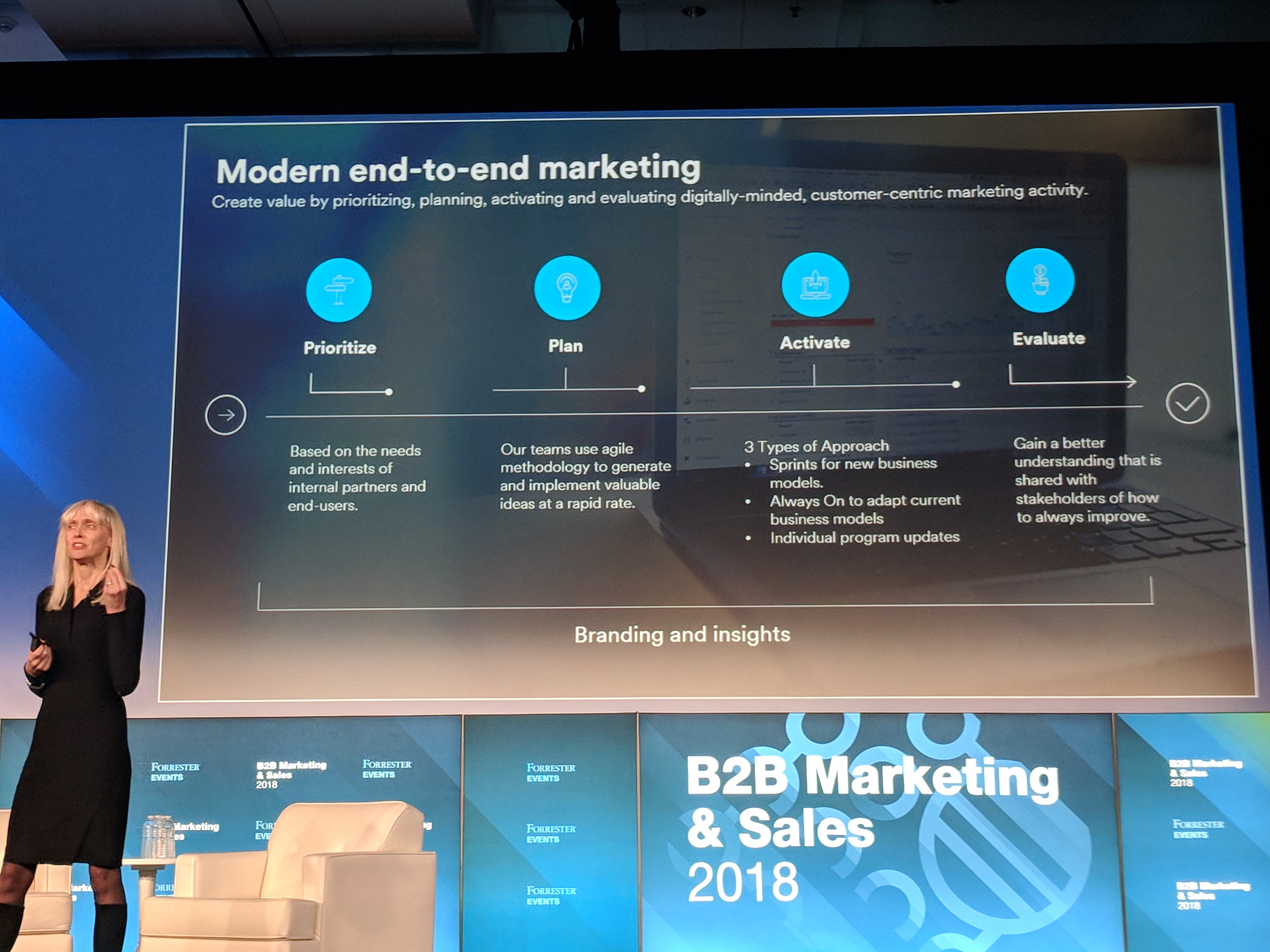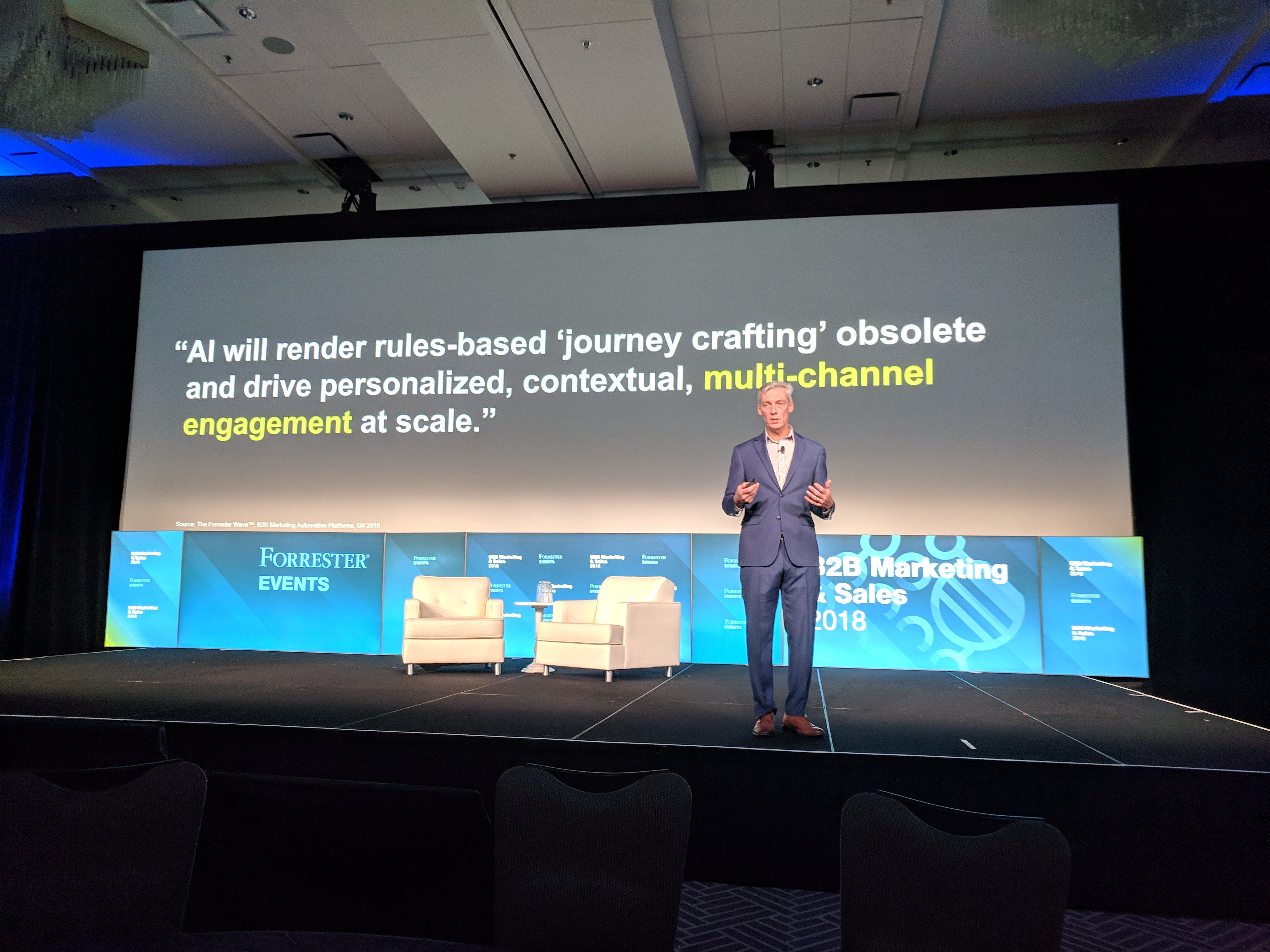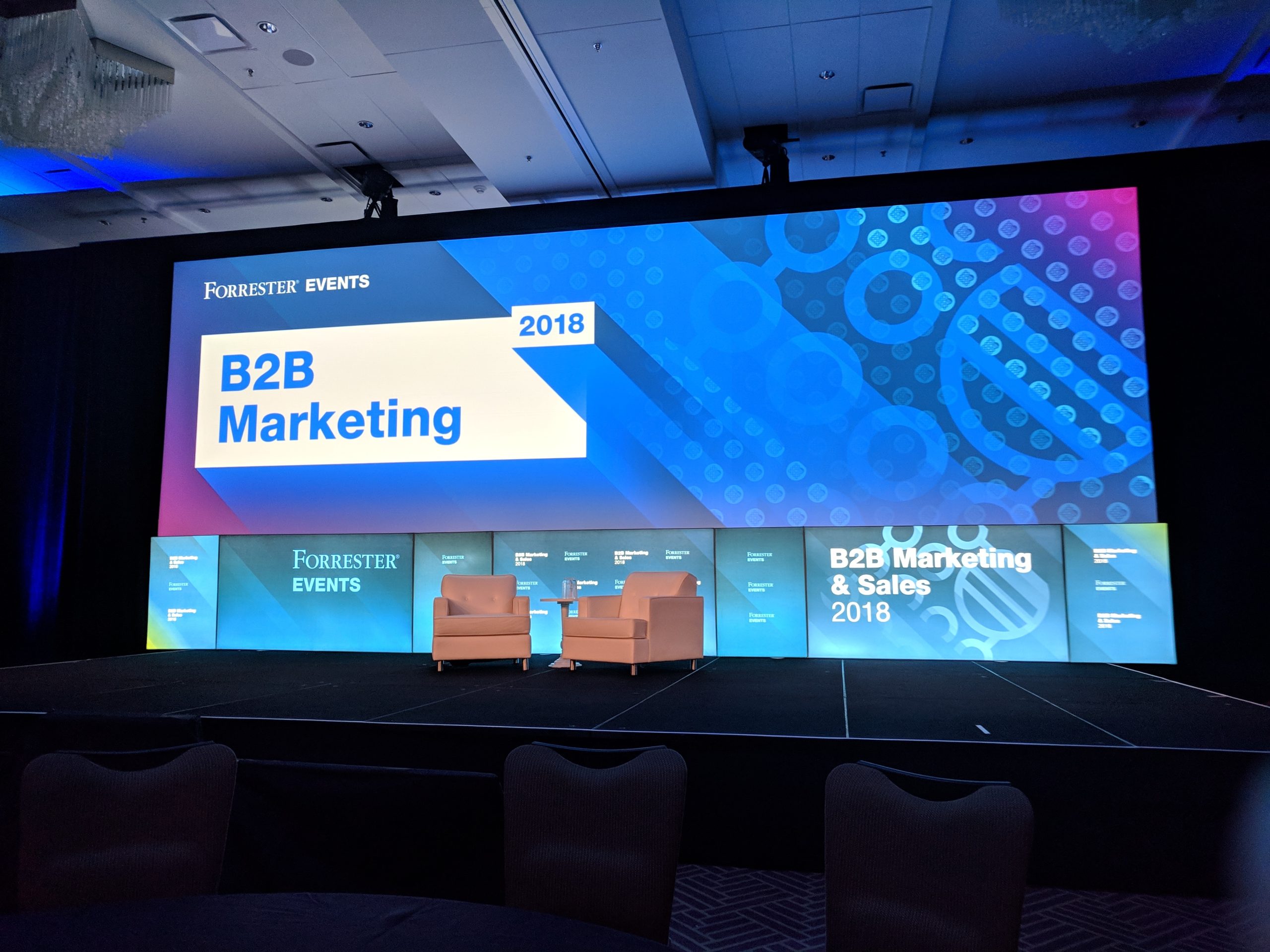The business consumer has become more self-focused than ever before, challenging marketing and sales teams to give up the reins of their buyers’ journeys and adapting their go-to-market strategies to fully embrace buyer expectations. This concept was discussed in detail during B2B Marketing & Sales 2018, an event hosted by Forrester Research in Austin on October 25-26. During the opening keynote, Forrester’s VP and Research Director Caroline Robertson detailed how B2B buyers today have grown even more indifferent to sellers — expecting to be the center of any form of engagement and to have outcomes that align to their own business goals.
“Your customers don’t really care about you,” Robertson said during her opening remarks. “They don’t care that you probably have dirty data that limits your ability to provide personalized experiences. They don’t care that your marketing and sales teams may not be working together properly. And they also don’t care that their buying process and journey is unpredictable.”
Robertson added that these new customers specifically want to be the center of the seller’s existence. “They want to know how you can solve their problems. They care about how you evolve with them in the long run and they ultimately care the most about their own success,” said Robertson.
So where should B2B companies begin? Presenters from the event agreed the messaging architecture that is fueling content for sellers must be addressed to follow these new expectations. Laura Ramos, VP and Principal Analyst at Forrester, shared research during one of her sessions that showed more than two-thirds (68%) prefer to research online on their own, while 62% finalize criteria via digital content only — with absolutely no engagement with a sales contact. This comes down to an overabundance of lackluster content that leaves buyers more inclined to consume it on their terms.
“As marketers, your customers are ignoring a lot of your content,” said Ramos. “They know it’s there, they just don’t care. This ultimately leads to $1 million wasted on content no one sees. They are doing this because they can. We need to put a foundation in place so our content is not ignored.”
Ramos added that current messaging foundations are weak, and a strategic messaging architecture must be implemented to focus on desirable outcomes for potential customers to address pain points that meet their needs.
She continued to highlight four quick steps to formulate that strategic messaging architecture:
- Know what you are, and what you’re not: “Every company in this room cannot do absolutely everything for everybody all the time. But current websites and content give off that impression.”
- Identify your best fit audience: “Its about identifying the people you should truly be engaging with and selling to,” Ramos said. “It comes back to adopting the fine art of segmentation, and it’s something companies need to do better to get their messaging right.”
- Talk about their problems: “Not what we want them to know about us, but that we understand what it’s like to be in their shoes,” Ramos noted.
- Show the shortfalls of other approaches: “Sure, there are other options out there,” Ramos added. “But messaging should focus on how those other approaches aren’t as good as the one you’re offering.”
“Business buyers don’t buy your products, they buy into your approach,” Ramos concluded. “Great messaging causes them to see their situation differently. To capture attention, a message must destabilize the current status quo, contrast today with a future state and eliminate the blame and regret that can come with a purchase.”
3M Dives Deep Into Buyer Needs To Modernize Marketing Strategy

During a case study presentation, Penny Wise, Director of Industrial Marketing at 3M, shared how she and her team were looking to evolve the company to use modern marketing techniques and create customer experiences that were relevant and sophisticated.
Wise detailed how the company wanted to establish 3M’s reputation as a leading, trusted source in the abrasives and industrial automation sector. First, the team identified the personas that influenced purchases the most — in the case of abrasives, this was process engineers that were hesitant to invest in robotics.
“In a world of shiny new objects, [the buyer’s] reputation is based on them finding the right tools that make them better versus just bringing on shiny tools,” said Wise.
When formulating content, Wise and her team realized they had a gap at the beginning of the buying journey. The company established a paid search campaign to understand search habits for process engineers, brand awareness and interest levels.
Identifying Facebook and YouTube as strong channels to engage their target audience, Wise and her team invested in creating mobile-friendly video content in-house, as well as additional supporting content such as a value calculator. Wise noted that the company invested roughly $2,000 in media, and the content has seen more than 35,000 impressions since its launch.
“We’re now responding to what the customers actually want in the customer journey,” said Wise. “In the first week of starting this campaign up, we generated four opportunities before really starting any demand gen or media activities.”
Growth Of AI Helping Businesses Create Dynamic Customer Experiences

Many presenters throughout the event highlighted how past attempts to “map the customer journey” have all been in vein. With buyers now in control, analysts noted that AI tools in particular are positioning businesses to offer dynamic customer experiences based on their engagement.
Steve Casey, Principal Analyst at Forrester, noted during his keynote that companies should create a dynamic customer experience for customers instead of dictating their journey. He compared this dynamic experience to chess, where both the seller and buyer are engaging in a variety of complex ways — oftentimes beyond human capabilities — to identify the quickest moves to get a desired outcome.
“From the buyer’s perspective, it’s a contextual and orchestrated single experience — it’s not disjointed,” said Casey. “That’s the experience we need to strive towards.”
This is where AI has begun to grow within the B2B marketplace, according to Casey. He added that it ultimately has gotten to the point where AI will soon render rule-based customer journeys obsolete, leading to more personalized, contextual, multi-channel engagement at scale.
“Creating the ‘golden path’ of a B2B purchase is impossible,” said Casey. “To create a customer-driven lifecycle, we need to create an ecosystem that is not only learning from past purchases and engagement, but also learning and anticipating how buyers will move ahead.”
Most of the analysts that took the stage noted how today’s use cases for AI are strong in the early and late stages of the sales cycle, but Forrester predicts that this will only continue to grow into the complex mid-stage of the sales funnel throughout 2019. In one of Forrester’s latest reports, Predictions 2019: B2B Marketing And Sales, the company predicts that more than 20% of marketing platforms will use AI to optimize midcycle engagement.
Early use cases have shown how AI impacts the way B2B companies go to market. During the event, Annalisa Church, Sr. Director of Marketing Technology at Akamai, shared how her team created an AI foundation for personalized buyer journeys.
The company incorporated Lattice Engines’ predictive analytics into its marketing initiatives to better segment, target and personalize messaging across all the digital channels. The company saw its lead-to-opportunity conversion rate rise by roughly 6X (from 2% to 12.5%), while also seeing the number of leads being sent to sales decrease.
“This is a scary thing for both the field marketers and sales,” said Church. “At Akamai, they were used to receiving very vast amounts of leads. The reality is that, for us, it’s been a saving — so we can now deploy dollars that we would normally spend on lead gen to other places, and it has allowed for focus with our sales people. The lead now holds more value to the sales team because they are much rarer and more likely to convert.”
Church suggested that predictive analytics adopters should identify a select number of use cases to drive outcomes and set expectations for stakeholders.
“When you start to throw around terms like predictive analytics, you can go in many different directions with it when it comes to use cases and KPIs,” she said. “We identified four use cases — even though we definitely could have more — and we’re going to stick to those and focus on driving results in those particular use cases.”
Identifying Metrics That Matter Requires Strong Sense Of Desired Outcomes
In a session with Allison Snow, Sr. Analyst at Forrester, she highlighted the importance of understanding a business’ goals and desired outcomes to help understand the metrics that matter to measure success.
“The metrics that matter demonstrate the health of our organization uniquely,” said Snow. “Every company’s top-five metrics should be different. Those metrics that you report on to help show the health of your business to key stakeholders within the organization should be unique, because you’re not trying to do the same thing every other company is doing.”
Snow outlined a balanced metrics portfolio:
- Brand: Analyze the health of awareness, consideration and reputation. Some suggested goals include increasing consideration rates, decreasing the risk perception associated with your brand or boosting inbound traffic. Some metrics that can be measured for this include positive movement in brand searches, testimonials from high-profile customers and mentions from named influencers.
- Demand: Analyze the health of programs, lead-to-revenue management and conversion. Some common goals include closing deals faster, understanding well-performing content and lead sources, as well as better forecasting and predictability. Some metrics that can be measured include velocity between sales stages, volume in new contacts in the database and opportunities generated.
- Expand: Analyze the health of customer satisfaction, loyalty and advocacy. Some common goals include increasing product usage (by segment, job title, etc.), increasing customer lifetime value and decreasing attrition. Some metrics that can be measured include conversion rates from customer to advocate and volume trends in client-participating content (events, testimonials, etc.).
“Business metrics require a north star,” said Snow. “Marketers need to participate in dialogue around prioritized business outcomes and gain buy in. Only once this is established can marketers determine which metrics they should capture and expose. The alternative is to prioritize everything.”







